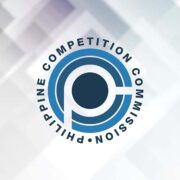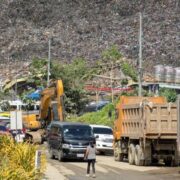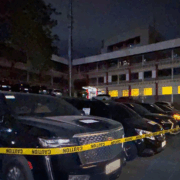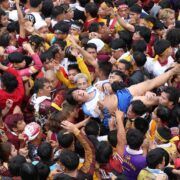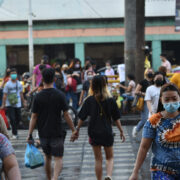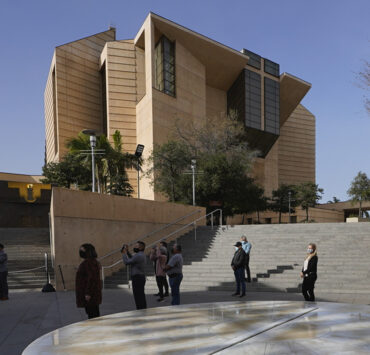Reverse-engineering of PNP’s mandate (2)
Can the Philippine National Police transform itself into a police force that is highly capable, effective, and credible?
The question has taken on a greater significance after former Police Col. Royina Garma claimed that some of her colleagues, including those who were close to then President Rodrigo Duterte, had blood on their hands in pursuing the war on drugs.
For now, the public is reassured by the fact that the Marcos administration has brought about a change of guard in the police force since the end of the Duterte administration. But the PNP remains under scrutiny regarding its mandate derived from Republic Act No. 6975 (as amended). The mandate is actually the police force’s mission which is to “enforce the law, prevent and control crimes, maintain peace and order, and ensure public safety and internal security with the active support of the community.”
The use of big words like these often leads to discussions about any reform or change agenda that will continue to eliminate misfits from the force and enhance law enforcement capabilities.
‘Transformational journey’
As I’ve discussed in my previous column, transformation has been the overarching goal of the “PNP P.A.T.R.O.L. Plan 2030,” a long-term strategic framework which stands for “Peace and Order Agenda for Transformation and Upholding the Rule of Law.”
Remember that the PNP’s mandate is clearly stated in the law that created it in 1991. But because of observed organizational weaknesses, dysfunctions and threats (amid rising crimes in the 1990s and early 2000s), various programs were introduced to reform the PNP.
There were significant accomplishments, but it became “apparent that the PNP was in need of a transformation plan that is more long-term and holistic in character,” according to a briefer on “Transformational Journey of the PNP” provided by the PNP Center for Police Strategy Management (CPSM).
Thus, the PNP Integrated Transformation Program (ITP) was born in 2005, featuring 34 projects to resolve the dysfunctions and improve the quality of police services, among other notable objectives. The need to comply with the Millennium Challenge Corporation’s criteria for financial grant for the country in 2009 and the PNP-ITP assessment in 2010 accelerated the change agenda, paving the way for the institutionalization of the Performance Governance System (PGS) at the PNP and five other government agencies.
The Patrol Plan envisions a two-pronged output: enhanced police capability and a safer community. The PNP seeks to be, by 2030, “a highly capable, effective, and credible police service working in partnership with a responsible community towards the attainment of a safer place to live, work, and do business,” according to the plan’s roadmap.
The CPSM explained that for the PNP to become highly capable, its officers need to be fully equipped; to be competent, the police must have sufficient training to prevent and solve crimes effectively; and to be credible, they must gain the trust of the people by working to improve the image and service reputation of the police.
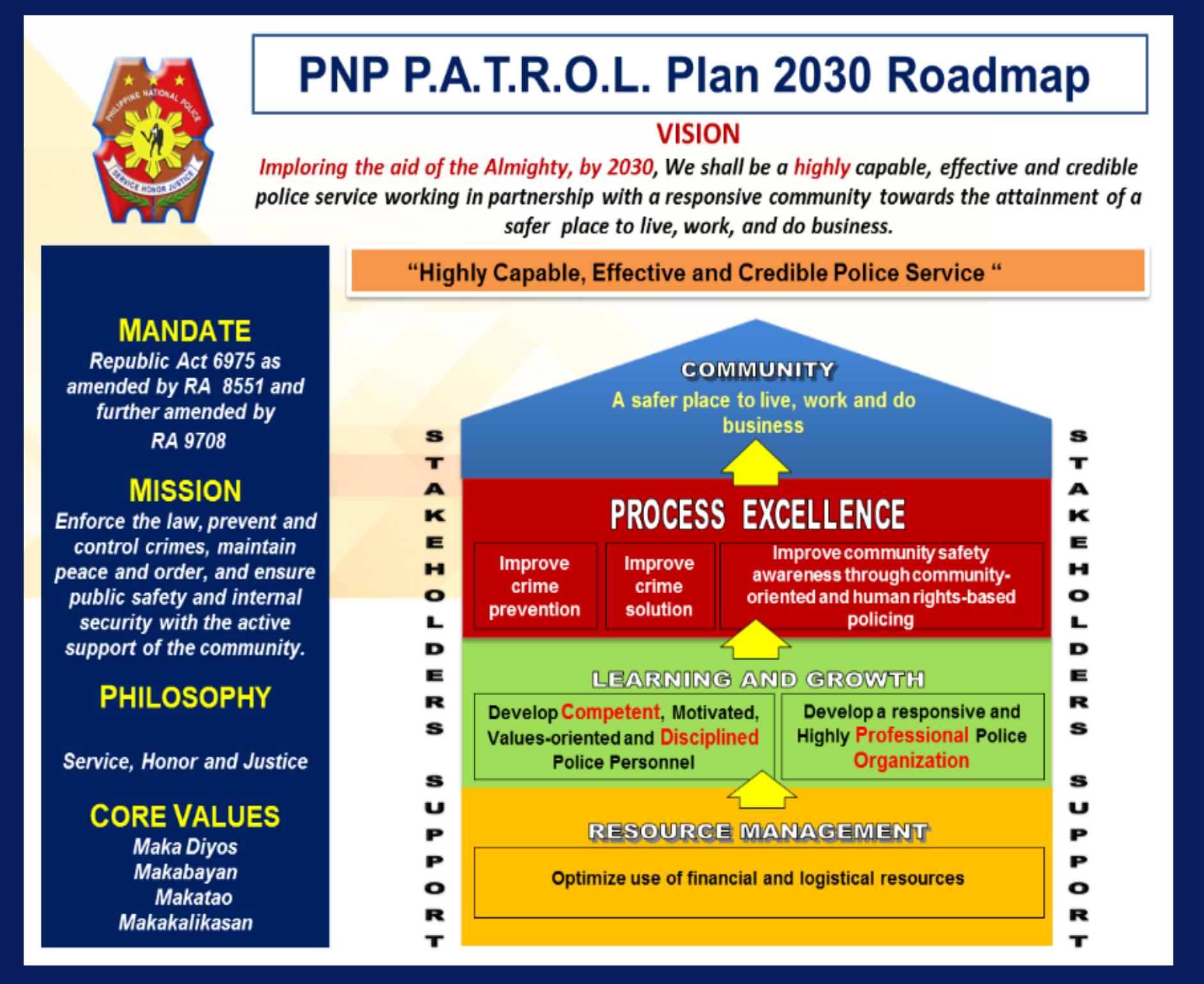
Performance-based
Since 2010, the PNP has embarked on a continuous training and performance-based audit of its compliance with its mandate. This has been a process of reverse engineering of sorts, in which the organization has sought to analyze its strengths and weaknesses, as well as gain insights into its systems and processes, to determine what works and what doesn’t.
Several entities are conducting training, such as the Philippine Public Safety College for mandatory courses like Officers’ Basic, Advance, and Executive Courses, while the Training Service conducts specialization courses like investigation, intelligence, and forensics, among others.
It should be noted that PGS is the heart of the change agenda, as the Patrol Plan is based on this framework. “[It] aims for transparent, accountable, and results-based governance” by using a “balanced scorecard approach to measure the performance of police units and personnel,” according to the Patrol Plan briefer.
Resource management (optimization), learning and growth (enhancing competence, motivation, values, discipline), and process excellence (where crime prevention and solution, and human rights-based policing are rated) are all part of the strategy roadmap. All of these are geared toward creating a community that is a safer place to live, work, and do business.
The Patrol Plan has led to reforms in the PNP budget system, such as the bottom-up participatory budgeting process and the decentralization of funding distribution, and the modernization of the logistical resources of the police service, which include police cars, watercraft, and aircraft. From a baseline of 67 percent and 31 percent in 2010, the provision of firearms and investigative equipment increased to 105 percent and 60 percent, respectively, in 2019, PNP data shows.
Scorecard
The scorecard is also a game-changer in all these reform efforts, as PGS subjects police officers to a quarterly review of their performance, which includes accomplishments, competence, and integrity, instead of using loyalty as a basis for promotions and re-assignments.
Specifically, the PNP scorecard operationalizes the strategy map through objective-setting, measures or key performance indicators, targets and actual accomplishments, and initiatives (i.e., programs, projects, and activities). For instance, the objective (desired outcome) of crime prevention is only achieved by reducing crime volume. Measures consist of conducting patrols, neutralizing criminals, and maintaining police community relations.
Thus, at the time the PNP’s PGS was certified as institutionalized in 2019, “the dysfunctions identified in 2005 … have either been addressed or have shown considerable improvement. The PNP now has optimized use of limited resources, sufficient government funding resulting in adequate resources for programmed activities, decentralized funding distribution, sufficient logistical support given to police stations, and sufficient fill-up in basic logistical resources,” the CPSM briefer stated.
Our hope is that the upward trajectory will continue, even as the PNP is constantly fine-tuning the roadmap due to police-related issues hogging the limelight and constant feedback from the public, including the civilian-led Advisory Groups.
One major challenge with the scorecard is the reporting requirement (monthly for operations review and quarterly strategy review). With the police already facing significant paperwork for their investigations and operations, reducing paperwork for PGS-related compliance and monitoring reports would be most welcome. Conducting community relations programs that have little to do with policing is also worth revisiting.
Uncluttering their schedules allows the police to have more time for training, patrolling, and solving crimes.
For comments: mubac@inquirer.com.ph

